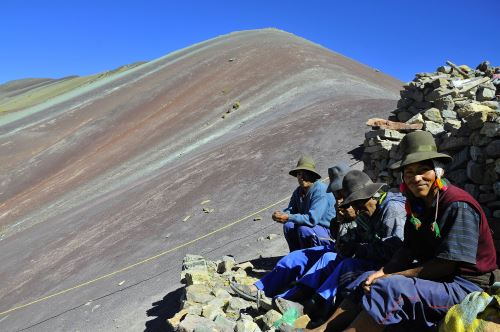10:21 | Cusco (Cusco region), Feb. 24.
Unveiled to the world by global warming ice-melting, the unique Winikunka (Quechua for 'Seven-color Mountain') proves an increasingly popular destination in Andean Cusco region.

Winikunka is an innovative option for those seeking natural tourist attractions. This colorful mountain rises at over 5,000 m.a.s.l. and is accessible from a hiking trail that passes through breathtaking landscapes.
And it does not stand alone. The Rainbow Mountain is part of the Vilcanota Mountain range and lies close to the majestic Ausangate snow peak, Peru's fifth highest mountain, at 6,372 m.a.s.l.
Its reddish, greenish and yellowish shades are the result of sedimentary rocks eroding for millions of years.
While reaching this natural masterpiece is not as lengthy, it does require a plan, healthy physical condition and eagerness to enjoy the various landscapes presented on route to the multi-color summit.
The route
The tour begins in the wee hours as the bus sets out from Cusco city, passing Andahuaylillas, Quiquijana and Checacupe localities on the way to
Pitumarca (Canchis province), a picturesque town south of Cusco.
Two transport companies offer the Sicuani-Checacupe service in Cusco, nearby Cerrado Coliseum on Huayruropata Avenue. Tickets to Pitumarca are about S/5 (about US$1.5).
Once there, the 3-hour hike begins. Entry tickets are S/5 for Peruvians and S/10 (about US$3) for foreigners.
Horseback riding is also available for those who are not into long treks. However, horses are only allowed to go so far, so after a certain point, on-foot is the only way.
Whether on horseback or on foot, the journey is a feast for the eyes: stunning landscapes featuring glaciers and several lagoons; shepherds herding llamas, alpacas, and sheep; as well as wild species like foxes, deer, and condors, just to name a few.
Eagle views await at the top, where visitors can fully take in the spectacular scenery, the Ausangate peak towering in the backdrop.
The way back to Pitumarca valley is along the same route, although not as strenuous as the way up. After an energy-boosting lunch, visitors are taken back to the Imperial City, arriving early in the evening.
Travel tips
Getting used to the height prior to the tour is recommended. Two days should be enough to adapt to it.
Experience hiking or walking long distances is also a plus, as the steep rise poses a challenge for first-timers (and is not for children).
Packing light is recommended, as excess wait only makes the trek harder.
The packing list should include: trekking boots with good grip, walking sticks, warm clothes, sunscreen, a cap, gloves, sunglasses, medicines, snacks, rehydration drinks and ponchos, particularly now given the rain season, set to run thru March.
(END) MAO/MVB
Published: 2/24/2018